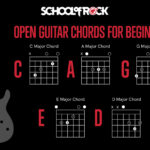The B Guitar Chord is a fundamental chord in music, appearing in countless popular songs across genres. From the classic rock anthem “American Woman” by The Guess Who to Miranda Lambert’s country hit “Little Red Wagon” and Cheap Trick’s power-pop tune “Dream Police,” the B chord’s versatility is undeniable. While it might present a steeper learning curve than beginner-friendly open chords due to its barre chord nature, mastering the B chord unlocks a vast repertoire of songs and expands your guitar playing capabilities.
This guide will explore the most common ways to play the B major chord, including the standard barre chord positions and several easier alternatives for beginners. We’ll also provide practice tips to help you smoothly incorporate this essential chord into your playing.
Understanding the B Major Chord
Before diving into finger positions, let’s briefly understand what constitutes a B major chord. A major chord is built with a root, a major third, and a perfect fifth. In the case of the B major chord, these notes are:
- Root: B
- Major Third: D# (D sharp)
- Perfect Fifth: F# (F sharp)
These three notes are present in all variations of the B major chord, giving it its characteristic bright and uplifting sound.
Two Common Ways to Play the B Major Chord (Barre Chords)
The two most prevalent ways to play the B chord are barre chord shapes, demanding a bit more finger strength and dexterity as they require fretting multiple strings with one finger.
B Major Chord in the 2nd Position (A-shape barre)
This B major chord position is based on the A major open chord shape, moved up the neck and barred at the 2nd fret.
Finger Placement:
- Index finger: Barre across all six strings at the 2nd fret. Ensure all strings are pressed down cleanly.
- Middle finger: Place on the 4th fret of the D (4th) string.
- Ring finger: Place on the 4th fret of the G (3rd) string.
- Pinky finger: Place on the 4th fret of the B (2nd) string.
Strumming: Strum four strings down from the A string (5th string). Avoid strumming the low E string.
This 2nd position B chord, while sounding full, can be challenging for beginners due to the finger strength required to barre effectively so close to the guitar’s nut.
B Major Chord in the 7th Position (E-shape barre)
The second common barre chord position for B major is at the 7th fret, utilizing the E major open chord shape as its foundation.
Finger Placement:
- Index finger: Barre across all six strings at the 7th fret. Again, ensure a clean barre across all strings.
- Middle finger: Place on the 8th fret of the G (3rd) string.
- Ring finger: Place on the 9th fret of the A (5th) string.
- Pinky finger: Place on the 9th fret of the D (4th) string.
Strumming: Strum all six strings from the low E string.
The 7th position B chord offers a richer, fuller sound as it utilizes all six strings. However, like the 2nd position, it requires solid barre chord technique.
Alternate Versions of the B Chord (Easier Options)
If barre chords are proving difficult, especially when starting, several alternate versions of the B chord can provide easier fingering without sacrificing too much of the chord’s essential sound.
Simplified B Chord (No Bass B)
This variation simplifies the 2nd position B barre chord by removing the lowest B note, making it significantly easier to fret.
Finger Placement:
- Index finger: Place on the 2nd fret of the high E (1st) string.
- Middle finger: Place on the 4th fret of the D (4th) string.
- Ring finger: Place on the 4th fret of the G (3rd) string.
- Pinky finger: Place on the 4th fret of the B (2nd) string.
Strumming: Strum four strings down from the D string (4th string).
This simplified B chord still retains the major quality and sounds surprisingly full, making it a great option for beginners or when quick chord changes are needed.
Bsus4 as a B Chord Alternative
Another interesting alternative is using a Bsus4 chord shape. While technically not a B major chord, it offers a similar harmonic function in many musical contexts and is easier to finger.
Finger Placement:
- Index finger: Place on the 2nd fret of the A (5th) string.
- Ring finger: Place on the 4th fret of the D (4th) string.
- Pinky finger: Place on the 4th fret of the G (3rd) string.
Strumming: Strum five strings down from the A string.
This Bsus4 chord creates a more open and airy sound compared to the standard B major, adding a unique flavor to your playing. It can be a refreshing alternative and is easier on the fingers.
3-Note Versions of the B Chord (Even Simpler)
For ultimate simplification, especially in lead guitar or fills, 3-note versions of the B chord are incredibly useful. They capture the essence of the chord with minimal fingering.
3-Note B Chord (High Strings)
This version focuses on the higher strings, creating a bright and cutting B chord sound.
Finger Placement:
- Index finger: Place on the 2nd fret of the high E (1st) string.
- Ring finger: Place on the 4th fret of the G (3rd) string.
- Pinky finger: Place on the 4th fret of the B (2nd) string.
Strumming: Strum three strings down starting on the G string (3rd string).
3-Note B Chord (Mid Strings)
This version utilizes the middle strings, offering a different tonal color for the B chord.
Finger Placement:
- Index finger: Place on the 8th fret of the G (3rd) string.
- Middle finger: Place on the 7th fret of the B (2nd) string.
- Ring finger: Place on the 7th fret of the high E (1st) string.
Practice Exercise: Mastering the B Chord Transitions
Once you can finger a B chord version, the next step is practicing transitions to and from it. Smooth chord changes are crucial for musical playing.
A common key where the B chord appears is E major. Effective practice exercises include transitioning between:
- E major to B major and back: Play an open E major chord for four beats, then switch to the 2nd position B major chord for four beats, and then back to E major. Repeat this cycle, gradually increasing speed as you become comfortable.
- A major to B major and back: Similarly, practice transitioning between an open A major chord and the B major chord in 2nd position.
Consistent practice, focusing on clean and quick transitions, will solidify your B chord mastery. Start slowly and gradually increase tempo.
Conclusion
The B guitar chord, while initially challenging due to its barre chord forms, is an essential chord to learn for any guitarist. By understanding the different positions, exploring easier alternatives, and practicing transitions, you can confidently incorporate the B chord into your playing. Don’t be discouraged if barre chords take time to master. Start with easier versions and gradually work your way towards the full barre chord positions. With persistence and practice, you’ll unlock the musical potential of the B major chord and expand your guitar playing horizons.
To further your chord vocabulary, explore Fender Play’s comprehensive chord library for more chord types and masterclass tips to enhance your guitar skills. Start your free Fender Play trial today and embark on a rewarding musical journey!


